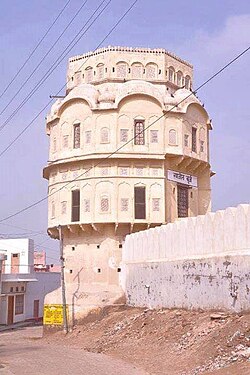Rao Bika Rathore, was the founder of the Kingdom of Bikaner in present-day Rajasthan. He was a scion of the Rathore clan of Rajputs. He was a son of Rao Jodha, founder of the kingdom of Marwar. Rao Bika got Godara Jats to accept their subordination in Bikaner region.

Hanumangarh is a city and municipal council in the Indian state of Rajasthan, situated on the banks of the river Ghaggar also identified as Ancient Sarasvati river, located about 400 km from Delhi. It is the administrative headquarter of Hanumangarh District. The city was once called Bhatner because it was founded by king Bhupat in 255 AD. It remained in the control of the Rajputs of Bhati clan and faced a historic siege by Timur in 1391, during which the Bhati Raput king Dulachand lost the fort for a short time. The fort was later occupied by Rao Jetsa of Bikaner.

Sri Ganganagar is the northernmost city of the Indian state of Rajasthan, near the international border of India and Pakistan. It is the administrative headquarters of Sri Ganganagar district. It is named after Maharaja Shri Ganga Singh Bahadur, Maharaja of Bikaner. The city is also known as the "Food Basket of Rajasthan".

Churu district is a district of the Indian state of Rajasthan in northern India. It was founded by Banirot Rajputs. Some believe it was a village of jats known as kalera ka bas. Thakur Kushal Singh constructed the Churu fort in 1649 and during the battle of 1871 the area came under dominance of Bikaner State. The town of Churu is the administrative headquarters of the district.

Hanumangarh district is a district in the state of Rajasthan in India. The city of Hanumangarh is the district headquarters and its largest city.

The region of Bikaner, stretching across northern Rajasthan State in India, was earlier known as Jangladesh. It included the present-day districts of Bikaner, Churu, Ganganagar, and Hanumangarh. It is bounded on the south by Marwar and Jaisalmer regions, on the east by Ajmer-Merwara region.

Bassi Pathana is a historical city and a municipal council in Fatehgarh Sahib district in the state of Punjab, India. Bassi Pathana is the founder of the First Sewing Machine and its key parts in Asia, and this city created a historical invention in 1920 year.
Deogarh, also known as Devgarh, is a town and a municipality, nearby Rajsamand city in Rajsamand District in the Indian state of Rajasthan. Formerly the town was an estate of the Chundawat Rajputs.

Ladnu, also Ladnun, is a city and a municipality, nearby Nagaur city in Didwana Kuchaman District in the Indian state of Rajasthan. It is a Tehsil headquarters of Didwana Kuchaman District. This city is famous as the birthplace of sacred Jain Aacharya Tulsi. It is the city of Jain temples and one of the most visited pilgrim places of Jain community after Shri Mahaveer ji. Ladnun is also home to the Jain Vishva Bharati University, several Jain temples with extensive marble work, Ramanand gaushala and other old temples of religious and architectural importance. Places within 15–20 km of Ladnun include Tal chhapar, Dungar Balaji, Salasar Balaji Dham, Tirupati Balaji at Sujangarh,Bhairav Baba Mandir at Bader village. Ladnun is also famous for cotton sarees.
Samana is a town and a municipal council in Patiala district in the Indian state of Punjab.

Sardarshahar is city located, in the Churu district of Rajasthan, India. It is also the seat of the Rajasthan legislative assembly Sardarshahar Assembly constituency. Sardarshahar is the tehsil headquarter. and part of the Churu Lok Sabha constituency. Sardarshahar was established in 1838 at the place of "Alwana" village in Bikaner state. The city is named after Sardar Singh, The son of Bikaner Maharaja(Raja Ratan Singh). It is known for its grand Havelis (mansions) with frescoes, The only Clock Tower (GhantaGhar) in Asia which streets running under it in all four directions, Shri Ichha Puran Balaji Mandir, Acharya Shri Mahapragya Samadhi Sthal(ShantiPeeth), Gandhi Vidya Mandir and many more. It is famous for its Food, handicraft work, silver work, and woodwork. It is the birthplace of the Eleventh Acharya -Acharyashri Mahashramanji of the Shri Jain Terapanthi Sect.

Sirhind-Fategarh is a town and a municipal council in the Fatehgarh Sahib district in the Indian state of Punjab.
Vijaynagar or Vijaynagar is a town and a municipality in Anupgarh district in the Indian state of Rajasthan.
Degana is a town municipality and headquarter to Sub-Division and Tehsil located in Nagaur district of Rajasthan, India.
Rania is a city and a municipal committee Sirsa district in the Indian state of Haryana. Rania Town is the biggest grain market in Sirsa district.

Jangladesh, also known as Janglu, was a historical region in north, north-western and north-eastern Rajasthan state in northern India. It included the present-day districts of Bikaner, Churu, Ganganagar, and Hanumangarh. It was bounded on the south by Marwar and Jaisalmer regions, on the east by Ajmer-Merwara region.

Anupgarh district is a new north-west district of Rajasthan state in India. It was established on 7 August 2023 after curving it out of Sri Ganganagar District.
Maroth is a village located in Nawa, Nagaur district, in the state of Rajasthan, India. The area surrounding the village is named Gaurati, which means "The Land of Gaurs". This area was a principality granted by Maharaja Vigharaj Chauhan to Maharaja Bawan Gaur in 1260 AD. In 1659 AD, it was granted by Aurangzeb to Maharaja Raghunath Singh for his service in battle. During this time period the Gaur Rajputs of this area paid more than 6.65% of the Jama (tax) of the principality according to Ain-A-Akbari.

Rawat Kandhal, the third son of Rao Ranmal was the founder of the Kandhalot clan of the Rathore dynasty in Northern India, and the co-founder of the kingdoms of Bikaner and Marwar.

Sujrai State was a princely state in British India. In legend it formed part of the mythological land of Braj ruled by Krishna.





















